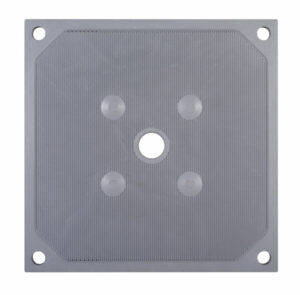As industries continue to evolve, the need for efficient and effective methods of separating solids from liquids is becoming increasingly important. As plate and frame filter press manufacturers, we have involved in this industry over 10 years. So in this post, we will explore one such method – the plate and frame filter press. We will cover the working principle of the plate and frame filter press. Also discuss about its design, operation, as well as the advantages it offers over other filtration methods.
What is Plate and Frame Filter Press?
A plate and frame filter press is a type of filtration equipment used for separating solid particles from liquids. It is widely employed in industries such as wastewater treatment, chemical, pharmaceutical, food and beverage, and mining.
Plate And Frame Filter Press Design & Diagram
The key components of a plate and frame filter press are the filter plates and filter frames. These elements are arranged alternately, creating a series of chambers for the slurry (mixture of solid and liquid) to pass through. The filter plates are usually made of polypropylene or stainless steel, while the filter frames can be made of various materials, such as plastic or metal.
The plate and frame filter press design is characterized by its simplicity and modularity, allowing for easy customization according to specific needs. A typical plate and frame filter press diagram includes a feed inlet, a series of filter plates and frames, filter cloth, a hydraulic system for closing and opening the press, and a filtrate discharge system.

Plate And Frame Filter Press Operation
The operation of a plate and frame filter press can be summarized in four main steps:
Filling: The slurry is pumped into the filter press, filling the chambers formed by the filter plates and frames.
Filtration: As the slurry fills the chambers, the solid particles are trapped by the filter cloth while the liquid, called filtrate, passes through and is collected in a separate container.
Cake Formation: Over time, the solid particles form a cake on the filter cloth, which further aids in the filtration process.
Discharge: Once the filtration process is complete, the hydraulic system opens the press, allowing for the removal of the solid cake and cleaning of the filter cloth before the next cycle begins.
Working Principle Of The Plate And Frame Filter Press
The working principle of the plate and frame filter press is based on the application of pressure to force the liquid through the filter cloth while retaining the solid particles. This pressure is typically generated by a hydraulic system, which compresses the filter plates and frames together, creating a seal that prevents the slurry from bypassing the filter cloth.
Advantages Of Plate And Frame Filter Press
The plate and frame filter press manufacturers offer several advantages over other filtration methods, such as:
High filtration efficiency: The filter press can achieve high levels of solids separation, resulting in clear filtrate and dry cake.
Modular design: The press can be easily customized to accommodate different capacities and applications.
Low maintenance: The simple design and construction of the filter press require minimal maintenance and are easy to clean.
Environmentally friendly: The filter press promotes the reuse of water and minimizes waste, contributing to sustainable practices.

